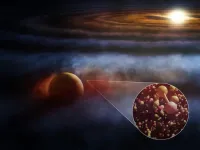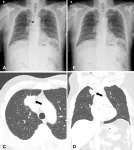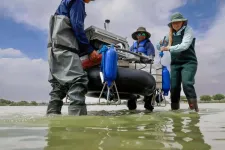(Press-News.org) Scientists using the Atacama Large Millimeter/submillimeter Array (ALMA) to study the protoplanetary disk around a young star have discovered the most compelling chemical evidence to date of the formation of protoplanets. The discovery will provide astronomers with an alternate method for detecting and characterizing protoplanets when direct observations or imaging are not possible. The results will be published in an upcoming edition of The Astrophysical Journal Letters.
HD 169142 is a young star located in the constellation Sagittarius that is of significant interest to astronomers due to the presence of its large, dust- and gas-rich circumstellar disk that is viewed nearly face-on. Several protoplanet candidates have been identified over the last decade, and earlier this year, scientists at the University of Liège and Monash University confirmed that one such candidate— HD 169142 b— is, in fact, a giant Jupiter-like protoplanet. The discoveries revealed in a new analysis of archival data from ALMA— an international collaboration in which the National Science Foundation’s National Radio Astronomy Observatory (NRAO) is a member— may now make it easier for scientists to detect, confirm, and ultimately characterize, protoplanets forming around young stars.
“When we looked at HD 169142 and its disk at submillimeter wavelengths, we identified several compelling chemical signatures of this recently-confirmed gas giant protoplanet,” said Charles Law, an astronomer at the Center for Astrophysics | Harvard & Smithsonian, and the lead author of the new study. “We now have confirmation that we can use chemical signatures to figure out what kinds of planets there might be forming in the disks around young stars.”
The team focused on the HD 169142 system because they believed that the presence of the HD 169142 b giant protoplanet was likely to be accompanied by detectable chemical signatures, and they were right. Law’s team detected carbon monoxide (both 12CO and its isotopologue 13CO) and sulfur monoxide (SO), which had previously been detected and were thought to be associated with protoplanets in other disks. But for the first time, the team also detected silicon monosulfide (SiS). This came as a surprise because in order for SiS emission to be detectable by ALMA, silicates must be released from nearby dust grains in massive shock waves caused by gas traveling at high velocities, a behavior typically resulting from outflows that are driven by giant protoplanets. “SiS was a molecule that we had never seen before in a protoplanetary disk, let alone in the vicinity of a giant protoplanet,” Law said. “The detection of SiS emission popped out at us because it means that this protoplanet must be producing powerful shock waves in the surrounding gas.”
With this new chemical approach for detecting young protoplanets, scientists may be opening a new window on the Universe and deepening their understanding of exoplanets. Protoplanets, especially those that are still embedded in their parental circumstellar disks such as in the HD 169142 system, provide a direct connection with the known exoplanet population. “There’s a huge diversity in exoplanets and by using chemical signatures observed with ALMA, this gives us a new way to understand how different protoplanets develop over time and ultimately connect their properties to that of exoplanetary systems,” said Law. “In addition to providing a new tool for planet-hunting with ALMA, this discovery opens up a lot of exciting chemistry that we’ve never seen before. As we continue to survey more disks around young stars, we will inevitably find other interesting but unanticipated molecules, just like SiS. Discoveries such as this imply that we are only just scratching the surface of the true chemical diversity associated with protoplanetary settings.”
The National Radio Astronomy Observatory (NRAO) is a major facility of the National Science Foundation (NSF) operated under a cooperative agreement by Associated Universities, Inc.
About ALMA
The Atacama Large Millimeter/submillimeter Array (ALMA), an international astronomy facility, is a partnership of the European Organisation for Astronomical Research in the Southern Hemisphere (ESO), the U.S. National Science Foundation (NSF), and the National Institutes of Natural Sciences (NINS) of Japan in cooperation with the Republic of Chile. ALMA is funded by ESO on behalf of its Member States, by NSF in cooperation with the National Research Council of Canada (NRC) and the National Science and Technology Council (NSTC) in Taiwan and by NINS in cooperation with the Academia Sinica (AS) in Taiwan and the Korea Astronomy and Space Science Institute (KASI).
ALMA construction and operations are led by ESO on behalf of its Member States; by theNational Radio Astronomy Observatory (NRAO), managed by Associated Universities, Inc. (AUI), on behalf of North America; and by the National Astronomical Observatory of Japan (NAOJ) on behalf of East Asia. The Joint ALMA Observatory (JAO) provides the unified leadership and management of the construction, commissioning, and operation of ALMA.
Media Contact:
Amy C. Oliver, FRAS
Public Information & News Manager, NRAO
+1-434-242-9584
aoliver@nrao.edu
END
A surprise chemical find by ALMA may help detect and confirm protoplanets
2023-06-27
ELSE PRESS RELEASES FROM THIS DATE:
AI model could help improve outcomes of prostate cancer focal therapy
2023-06-27
FINDINGS
A new study shows that an artificial intelligence (AI) model co-developed by researchers in the UCLA Jonsson Comprehensive Cancer Center and department of Urology at UCLA can help doctors determine the extent of cancer within the prostate.
In a series of tests, the AI model was found to be more accurate at predicting tumor margins than magnetic resonance imaging (MRI), potentially improving the effectiveness of focal therapy, standardizing treatment margin definition, and reducing the chance of cancer recurrence.
BACKGROUND
Focal therapy, a minimally invasive treatment approach used for localized tumors, is an alternative ...
Revealing the power of citizen science for SDG advancement
2023-06-27
The 17 SDGs are the blueprint to achieve a better and more sustainable future for all. They address the global challenges we face, including climate change, environmental degradation, and inequality. The achievement of the SDGs depends on the ability to accurately measure progress towards meeting the associated targets based on timely, relevant, and reliable data. Citizen science offers an innovative approach to complement and enhance official statistics. Additionally, citizen science can help raise awareness, mobilize action, and therefore achieve transformative change.
The collection ...
Bariatric surgery cuts risk for major cardiac events and death in patients with obesity and sleep apnea
2023-06-27
LAS VEGAS – June 27, 2023 – Bariatric surgery, also called weight-loss or metabolic surgery, was associated with a 42% lower risk of major adverse cardiovascular events (MACE), including heart failure, heart attack, stroke, and atrial fibrillation in patients with moderate to severe obstructive sleep apnea (OSA), according to a new study from Cleveland Clinic and presented here today at the American Society for Metabolic and Bariatric Surgery (ASMBS) 2023 Annual Scientific Meeting. Researchers also report metabolic surgery ...
New study finds fewer heart attacks, strokes and death among patients with diabetes and history of metabolic surgery
2023-06-27
LAS VEGAS – June 27, 2023 – Patients with diabetes and a history of metabolic surgery had significantly fewer heart attacks, strokes, hospitalizations and death compared to matched patients who did not have the surgery, according to a new study* presented here today at the American Society for Metabolic and Bariatric Surgery (ASMBS) 2023 Annual Scientific Meeting.
Patients reduced their chances of winding up in a hospital with a heart attack by more than 35%, a stroke by more than 25% and congestive heart failure by nearly ...
Bariatric surgery guidelines lowered BMI threshold for eligibility, but relatively few heeded the call
2023-06-27
LAS VEGAS – June, 27, 2023 – Patient eligibility for bariatric surgery, also called weight-loss or metabolic surgery, has expanded over the last decade and its safety and effectiveness even further established in clinical studies and professional guidelines, but relatively few patients with a body mass index (BMI) below 35 actually get the surgery in any given year, according to new studies presented here at the American Society for Metabolic and Bariatric Surgery (ASMBS) 2023 Annual Scientific Meeting.
In one study*, University of Southern California (USC) researchers found only 3.5% of the more than one million bariatric ...
New study finds diabetes remains in remission years after gastric bypass surgery regardless of weight loss
2023-06-27
LAS VEGAS – June 27, 2023 – More than half of patients with diabetes and a history of metabolic surgery (51%) experienced remission of their diabetes even if they did not achieve significant weight loss after surgery, according to a new study* presented here today at the American Society for Metabolic and Bariatric Surgery (ASMBS) 2023 Annual Scientific Meeting.
Researchers from Mayo Clinic in Rochester, University of California San Francisco in Fresno, and Stony Brook University Medical Center in New York performed a multicenter retrospective study of patients with diabetes who underwent gastric ...
More women are using single embryos during fertility treatment
2023-06-27
Copenhagen, Denmark: More women are having just one embryo transferred per cycle of fertility treatment to get pregnant, according to research presented at the 39th annual meeting of the European Society of Human Reproduction and Embryology (ESHRE) [1].
Preliminary data from the ESHRE European IVF-monitoring Consortium (EIM) [2] shows that nearly three in five (57.6%) out of all in vitro fertilisation (IVF) and intracytoplasmic sperm injection (ICSI) procedures in 2020 in Europe involved the transfer ...
Algorithm finds sperm in infertile men faster and more accurately than doctors
2023-06-27
Copenhagen, Denmark: A new artificial intelligence (AI) tool can identify sperm in severely infertile men in seconds compared to the hours it takes scientists, according to results presented today (Tuesday) at the 39th annual meeting of the European Society of Human Reproduction and Embryology (ESHRE) [1].
The study authors say the algorithm they have developed brings hope to men who want a biological child but have no sperm in their semen.
Currently, these patients must undergo a procedure where a portion of their testes is removed to help them become fathers. Embryologists extract sperm manually from this biopsy sample to fertilise the partner’s eggs ...
Lupus flare-ups strongly linked to specific bacterial growth in gut
2023-06-27
Recurrent bouts of systemic lupus erythematosus, marked by the body’s immune system attack of its own tissues, closely tracked with measureable upticks in growth in the gut of a certain species of bacteria.
New research from NYU Grossman School of Medicine shows that bacterial blooms of the gut bacterium Ruminococcus blautia gnavus occurred at the same time as disease flare-ups in five of 16 women with lupus of diverse racial backgrounds studied over a four-year period. Systemic lupus erythematosus involves damaging inflammation, especially in the kidneys, but also in joints, skin, and blood vessels. ...
This self-driving boat maps underwater terrain
2023-06-27
EL PASO, Texas (June 27, 2023) – Step aside self-driving cars, self-driving boats are here — and they can do more than take you on a cruise.
Researchers at The University of Texas at El Paso have constructed a fully autonomous boat that can carry out bathymetric surveys — surveys of the depth and terrain of bodies of water like oceans, rivers and lakes. The team hopes the robotic boat can help simplify the survey process, which usually takes a crew of individuals to complete, as well as assist ...


